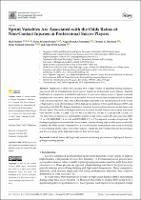Please use this identifier to cite or link to this item:
https://repositorio.usj.es/handle/123456789/712
| Title: | Sprint Variables Are Associated with the Odds Ratios of Non-Contact Injuries in Professional Soccer Players |
| Authors: | Nobari, Hadi



Mainer Pardos, Elena 


Denche-Zamorano, Ángel 

Bowman, Thomas G. 

Clemente, Filipe Manuel 

Pérez-Gómez, Jorge 


|
| Keywords: | Football; Injury risk; High load; External monitoring; Performance; High-speed distance; Global positioning system |
| Issue Date: | 3-Oct-2021 |
| Publisher: | MDPI |
| Citation: | Nobari, H.; Mainer-Pardos, E.; Denche Zamorano, A.; Bowman, T.G.; Clemente, F.M.; Pérez-Gómez, J. Sprint Variables Are Associated with the Odds Ratios of Non-Contact Injuries in Professional Soccer Players. Int. J. Environ. Res. Public Health 2021, 18, 10417. https://doi.org/10.3390/ijerph181910417 |
| Abstract: | Significant evidence has emerged that a high volume of sprinting during training is associated with an increased risk of non-contact injuries in professional soccer players. Training load has been reported as a modifiable risk factor for successive injury in soccer. Sprint workload measures and non-contact injuries were recorded weekly in twenty-one professional soccer players over a one season period. Odds ratio (OR) and relative risk (RR) were calculated based on the weeks of high and low load of total distance (TD), high-speed distance (HSD), sprint distance (SPD). and repeated sprints (RS). The Poisson distribution estimated the interval time between the last injury and the new injury. The weeks with high-load levels increased the risk of non-contact injury associated with TD (OR: 4.1; RR: 2.4), HSD (OR: 4.6; RR: 2.6), SPD (OR: 6.9; RR: 3.7), and RS (OR: 4.3; RR: 2.7). The time between injuries was significantly longer in weeks of low-load in TD (rate ratio time (RRT) 1.5 vs. 4.2), HSD (RRT: 1.6 vs. 4.6), and SPD (RRT: 1.7 vs. 7.7) compared to weeks of high-load. The findings highlight an increased risk of non-contact injuries during high weekly sprint workloads. Possibly, TD, HSD, and SPD measured via a wearable inertial measurement unit could be modeled to track training and to reduce non-contact injuries. Finally, the interval time between the last injury and the new injury at the high-load is shorter than the low-load. |
| URI: | https://repositorio.usj.es/handle/123456789/712 |
| ISSN: | 1661-7827 |
| Appears in Collections: | Artículos de revistas |
Files in This Item:
| File | Description | Size | Format | |
|---|---|---|---|---|
| Sprint Variables Are Associated with the Odds Ratios of Non-Contact Injuries in Professional Soccer Players.pdf | 352,92 kB | Adobe PDF |  View/Open |
This item is licensed under a Creative Commons License

